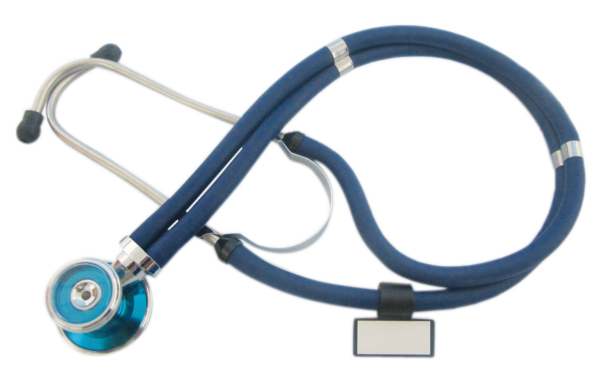
Sprague-Rappaport Stethoscope
The Sprague Rappaport Stethoscope is in one for a full range of diagnostic applications and is traditionally trusted to detect faint heart sounds and murmurs. It's the ultimate tool for listening to the heart and lungs, making it perfect for use by doctors and other healthcare providers.
| Ref. No.: | Description: |
|---|---|
| NMDE220603 | Navy blue head, navy blue tubing |
| NMDE220604 | Blue head, blue tubing |
Sprague Rappaport stethoscopes are a type of acoustic stethoscope that was first patented in the United States in 1925. The design of the Sprague Rappaport stethoscope is credited to Dr. Samuel J. Sprague and Dr. Philip G. Rappaport, who were both physicians at the time. The Sprague Rappaport stethoscope was designed to be more efficient than other types of stethoscopes on the market, and it quickly became popular among medical professionals. Today, Sprague Rappaport stethoscopes are still considered to be one of the best choices for a full range of diagnostic applications. They are known for their durability, precision, and comfort, and they continue to be used by doctors and nurses all over the world. If you're looking for a high-quality stethoscope that will last for years, a Sprague Rappaport stethoscope is an excellent choice!
Sprague Rappaport stethoscopes are one of the most popular choices for a full range of diagnostic applications. They are known for their durability and dependability, and are used by many medical professionals worldwide. Here are some tips on how to use a Sprague Rappaport stethoscope:
1. Inspect the stethoscope before use. Make sure that there are no cracks or damage in the tubing, and that the earpieces are clean and free of debris.
2. Place the diaphragm of the stethoscope against your patient's skin, using light pressure.
3. Listen for sounds using both ears, as this will help you to hear faint sounds more clearly.
4. If you need to hear high-pitched sounds, such as those made by valve closure or heart murmurs, place the bell of the stethoscope against your patient's skin instead of the diaphragm.
When it comes to choosing a stethoscope, there are many factors to consider. The Sprague Rappaport stethoscope is a classic choice that offers a full range of diagnostic applications. However, there are both pros and cons to using this type of stethoscope. On the plus side, the Sprague Rappaport stethoscope is known for its durability and accuracy. It is also comfortable to wear and easy to use. Additionally, this type of stethoscope can be used for a variety of different medical applications. On the downside, the Sprague Rappaport stethoscope can be more expensive than other types of stethoscopes. Additionally, it is not as portable as some other models and can be difficult to store when not in use.
The Sprague Rappaport stethoscope is one of the most popular and well-known types of stethoscopes on the market. It is often chosen by medical professionals for its full range of diagnostic capabilities. However, there are both advantages and disadvantages to using this type of stethoscope. Some of the advantages of the Sprague Rappaport stethoscope include its durability, its ability to pick up a wide range of sounds, and its versatility. This type of stethoscope is also relatively inexpensive, which makes it a good choice for budget-conscious consumers. However, there are also some disadvantages to using the Sprague Rappaport stethoscope. One of the biggest drawbacks is that it can be difficult to use if you are not accustomed to its design. Additionally, this type of stethoscope is not always comfortable to wear for long periods of time, and it can be heavy and bulky.
When you are in the market for a Sprague Rappaport stethoscope, there are a few things that you will want to keep in mind in order to ensure that you are getting the best possible product. First and foremost, you want to make sure that the stethoscope you purchase is of high quality. This means that it should be made from durable materials and have a good reputation among medical professionals. It is also important to consider the size of the stethoscope when making your purchase. This is because you will need to ensure that it is comfortable for you to wear, as well as being able to reach all areas of your body that you need to examine. Finally, you will want to take price into consideration when purchasing a Sprague Rappaport stethoscope. While these products are typically very affordable, it is important to find one that fits within your budget. By keeping these factors in mind, you can be sure that you are getting the best possible product for your needs.